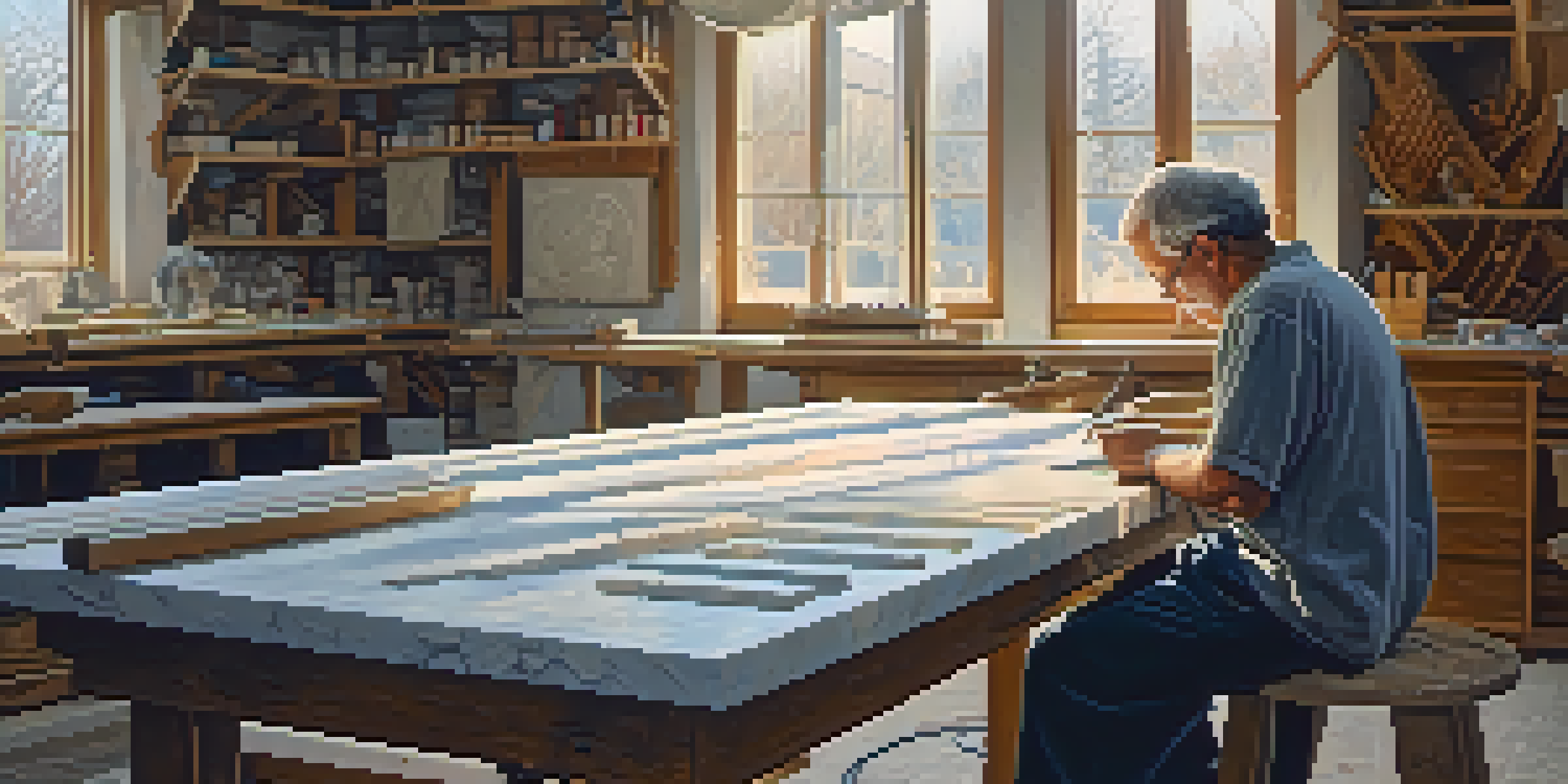Historical Significance of Carving in Religious Artifacts

Understanding Carving in Religious Contexts
Carving has long been a fundamental form of artistic expression in religious contexts. From ancient temples to modern churches, these intricate designs serve as both decorative and symbolic elements. Each carved relief or statue often tells a story, representing divine figures or significant events in a faith's history.
Art is the most beautiful of all lies; it is the most beautiful of all truths.
The act of carving is not merely about creating art; it's about communicating beliefs and values. The artists often infuse their own spirituality into their work, making each piece a personal testament to their faith. Moreover, these artifacts are intended to inspire devotion and reflection among worshippers, creating a sacred space.
Over time, carving techniques have evolved, influenced by cultural exchanges and technological advancements. Yet, despite these changes, the core significance remains unchanged: carving continues to be a vital medium for conveying religious narratives.
The Role of Carving in Ancient Civilizations
In ancient civilizations, like those of Egypt and Mesopotamia, carving played a crucial role in religious practices. Temples were adorned with detailed carvings that depicted gods, pharaohs, and mythological stories, each serving to bridge the gap between the divine and the earthly. These artifacts were not only decorative but also served as offerings to the deities.

For instance, the intricate hieroglyphs and bas-reliefs in Egyptian temples conveyed stories of creation, afterlife, and divine order. These carvings were believed to hold power, ensuring protection and favor from the gods. Such beliefs underscore the importance of carvings in ancient spirituality, as they were thought to facilitate communication with the divine.
Carving as Spiritual Expression
Carving serves as a powerful medium for conveying religious beliefs and values, inspiring devotion and reflection among worshippers.
The preservation of these carvings today allows us to glimpse into the religious practices of past civilizations. They remind us of the universal human desire to connect with something greater, demonstrating that art has always been a crucial element of worship.
Carving Techniques and Their Evolution
Carving techniques have evolved significantly over the centuries, influenced by available tools and cultural trends. Initially, simple hand tools were used, but as technology advanced, more sophisticated methods emerged. The introduction of chisels, hammers, and later, power tools, allowed for more intricate designs and finer details.
The purpose of art is not a rarified, intellectual distillate; it is life, intensified, and transformed.
Different cultures have developed unique carving styles, each reflecting their beliefs and artistic sensibilities. For example, Gothic cathedrals in Europe featured elaborate stone carvings that depicted biblical scenes, while Asian cultures often incorporated natural elements into their designs, showcasing harmony with nature.
This evolution in technique not only demonstrates human ingenuity but also reflects changing religious narratives. As religions adapted and grew, so too did the artistic expressions that accompanied them, highlighting the dynamic relationship between faith and art.
Symbolism in Carved Religious Artifacts
Symbolism is a key aspect of carved religious artifacts, with each element often carrying deeper meanings. For instance, the lotus flower in Hindu art symbolizes purity and spiritual awakening, while the cross in Christianity represents sacrifice and salvation. These symbols are not arbitrary; they serve to convey complex theological concepts in a visual form.
The choice of materials also adds layers of symbolism. For example, the use of marble might represent eternity and purity, while wood could symbolize life and growth. Such choices reflect the spiritual significance attributed to the artifacts, enhancing their role in worship and reflection.
Cultural Exchange Shapes Carving
Historical cultural exchanges have enriched the art of carving, blending diverse techniques and styles that reflect shared spiritual themes.
Understanding these symbols enriches our appreciation of religious art. It invites us to look beyond the surface and see the stories and beliefs that these carvings communicate, fostering a deeper connection with the spiritual traditions they represent.
Cultural Exchange and Its Impact on Carving
Throughout history, cultural exchange has significantly impacted the art of carving in religious artifacts. As civilizations interacted, they shared techniques, styles, and motifs, leading to a rich tapestry of artistic expression. This blending of influences can be seen in artifacts that combine elements from different religious traditions.
For example, the spread of Buddhism saw the incorporation of local artistic styles into its carvings, resulting in unique regional variations. Similarly, the Renaissance period in Europe was marked by the revival of classical themes, leading to a fusion of Christian iconography with Greco-Roman art.
Such exchanges highlight the interconnectedness of human cultures and the universal desire to express spirituality through art. They remind us that religious beliefs, while distinct, often share common threads that can be beautifully illustrated through carving.
Preservation of Carved Religious Artifacts
The preservation of carved religious artifacts is crucial for understanding historical and cultural contexts. Many of these pieces are vulnerable to environmental factors, war, and neglect, making their conservation a priority for museums and religious institutions alike. Efforts to restore and protect these artifacts help maintain their integrity and ensure that future generations can appreciate their significance.
Conservation techniques can vary widely, from physical repairs to digital documentation. For instance, 3D scanning technology allows for the creation of digital replicas, ensuring that even if the original is damaged, its history and artistry are preserved. This approach not only aids in preservation but also makes these artifacts accessible to a global audience.
Preservation of Religious Artifacts
Efforts to preserve carved religious artifacts are essential for understanding historical contexts and maintaining cultural heritage for future generations.
Furthermore, fostering awareness about the importance of these artifacts can encourage public support for preservation efforts. By engaging communities and highlighting the stories behind these carvings, we can work together to safeguard our shared cultural heritage for years to come.
The Modern Relevance of Carving in Religious Art
Today, carving remains a vital form of artistic expression within religious contexts, though its applications have evolved. Contemporary artists continue to explore traditional techniques while also experimenting with new materials and forms. This blend of old and new helps keep the art of carving alive and relevant in modern spirituality.
Many modern religious institutions commission artists to create carvings that reflect contemporary beliefs and values. For example, a church might feature a modern interpretation of biblical themes, resonating with today's congregation while honoring traditional practices. This dynamic allows for ongoing dialogue between past and present.

Ultimately, the enduring nature of carving in religious art speaks to its power to connect people across generations. As we engage with these artifacts, we not only honor our spiritual heritage but also invite reflection on the role of art in our faith journeys today.